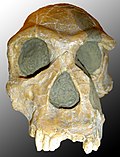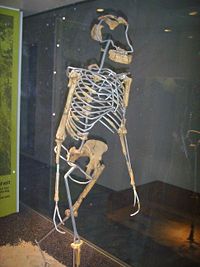|
Vikidia currently has 4,626 articles. Improve it! |
|
Join Vikidia: create your account now and improve it! |
Prehistoric man
Prehistoric men or prehistoric humans are the first and various people that used to live on the earth during the long period of the Prehistory. They belong to several species and genus, either very different of modern human and several million years's old or very closed to us, which master the language, the fire and tools making, from about one million years ago.
The scientific discipline that study these far ancestors is called paleoanthropology. It is a recent science, that has developed during the XXth century. Several unexpected and recent discovery enriched this field of knowledge these last years, bringing a new sight on the beginning of mankind.
Prehistoric and modern humans are members of the biological family Hominidae (the great apes).
First prehistoric humans[edit | edit source]

They are partial and recent finds which are still debated.
Toumaï[edit | edit source]
- 7 millions years ago. Presently the earlier known hominid. It is known by a piece of a skull that was found in Chad in 2001.
Orrorin tungenensis[edit | edit source]
- 6 millions years ago, yet only a few tooth and a femur were found, which seems to show that this hominid could stand and walk. It was discovered in Kenya in 2000.
Ardipithecus[edit | edit source]
Specie that was recognized in 2001. parts of bones and tooth were found in Ethiopia, showing he could stand.
Australopithecus[edit | edit source]
- 4 millions years ago. They are the earlier hominids to be quite well known. They were rather small (1,20 m) and could stand well.
Australopithecus africanus[edit | edit source]
- 3 millions years ago. They were discovered in South Africa in 1924-1925 by Raymond Dart.
Australopithecus afarensis[edit | edit source]
- 4 to 3 millions years ago. It is the famous « Lucy », discovered in 1974 in Ethiopia, and described by Yves Coppens (1978).
Australopithecus bahrelghazali[edit | edit source]
- 3 millions years ago. "Abel", discovered in Chad by Michel Brunet (1996).
Paranthropus[edit | edit source]
- 2 millions years ago. This australopithecus specie is more robust that the other ones. It was discovered in various African region during the 1930s to 1960s.
Human (genus Homo)[edit | edit source]

Homo habilis and Homo rudolfensis[edit | edit source]
- 2,5 millions years ago. They lived in Africa, in the savana. He still looked quite similar to the Australopithecus yet walked on his feet (bipede). He could speak, thought in a rudimental way and could make simple tools. He is omnivore, gatherer or scavenger.
Homo georgicus[edit | edit source]
- 1,8 million years ago. Discovered in 1999 in Georgia (Europe). Descent from Homo habilis, small cranial capacity. Big Jaw. First knapped stones.
Homo ergaster[edit | edit source]
- 1,7 million years ago. Discovered in 2000, in Georgia (Europe). He is another descent of Homo habilis, medium cranial capacity, the first man to have long legs and a right (vertical) stature. The first one to eat meat.
Homo erectus[edit | edit source]
- 700 000 to 300 000 years ago.
Tautavel Man[edit | edit source]
- 700 000 years ago. Hunter-gatherer and scavenger, he didn't faster the fire, which appears by the following Homo erectus 450 000 years ago.
Peking Man (Sinanthrope)[edit | edit source]
- 400 000 to 250 000 years ago.
Java Man (Pithecanthrope)[edit | edit source]
- 300 000 years ago.
Homo floresiensis[edit | edit source]
- Very small specie (1 m tall, 25 to 30 kg), looked like Homo erectus. This specie was extinct only 12 000 ago. It was discovered in Indonesia in 2003.
Homo antecessor[edit | edit source]
- 780 000 years ago. A new specie discovered in 1994, in Spain. It is the first human known in western Europe. His cranial capacity is about 1100 cm3.
Homo neanderthalensis[edit | edit source]
- 200 000 years ago. Neanderthal, dispareared 28 000 years ago. He lived in Europe and was stronger than modern man.
Homo sapiens[edit | edit source]
- 200 000 years ago. Firstly in Africa. He is the modern human, equal to ourselves.
Sources[edit | edit source]
Bibliography[edit | edit source]
- Ouvrage collectif, préfaces de Henry de Lumley et Yves Coppens, Histoire d'ancêtres, La grande aventure de la préhistoire, Artcom' / Errance, 2005

|
History Portal — All articles about history. |


